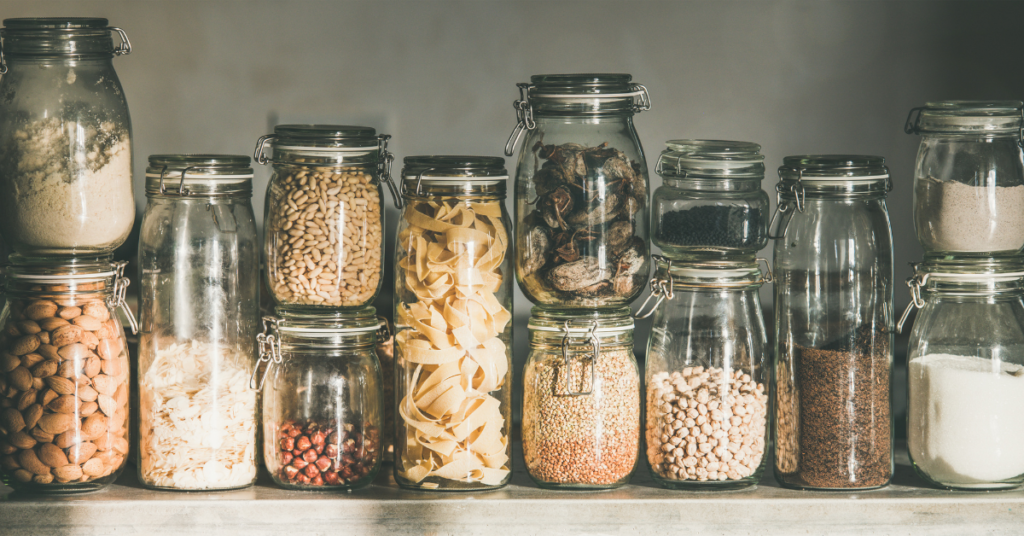In a world full of uncertainties, it’s essential to be prepared for any emergency, whether caused by nature or humans.
For preppers, survivalists, and homesteaders, having a reliable and sustainable food security plan is of paramount importance. Long-term food storage plays a vital role in ensuring a steady food supply during times of crisis.
In this article, we will examine seven effective methods for long-term food storage, namely Mylar Bags, Mason jars, Canning, Food-Grade Buckets with Oxygen Absorbers, Glass Jars with Fitted Lids and Rubber Protective Bands, Vacuum Sealer Bags, and Plastic Containers.
We will explore their unique properties, benefits, drawbacks, and suitability while providing insights into their significance for individuals engaged in preparedness.
Long-Term Food Storage – A Short Overview:
| Container | Grains | Dried Fruits | Canned Goods | Perishables (Meats, Dairy Products) |
|---|---|---|---|---|
| Mylar Bags | Up to 25 years | Up to 2 years | Not suitable for canned goods storage | Not suitable for perishable items storage |
| Plastic Containers | Up to 5 years | Up to 1 year | Up to 2 years | Meats: 2-4 days Dairy products: Refer to the expiration date on the packaging |
| Glass jars/Mason jars | Up to 2 years | Up to 1 year | Up to 2 years | Not suitable for perishable items storage |
| Vacuum Sealer Bags | Up to 2 years | Up to 1 year | Not suitable for canned goods storage | Meats: 2-3 years (freezer), 7-14 days (fridge) Dairy products: Not suitable |
| Plastic Food-Grade Buckets | Up to 5 years | Up to 2 years | Up to 2 years | Not suitable for perishable items storage |
Mylar Bags
Mylar bags are a popular choice for long-term food storage due to their moisture and light resistance, enabling protection against external elements that degrade food quality. These bags are often laminated with aluminum or metalized coating, acting as a barrier against oxygen and moisture to enhance shelf life. Mylar bags are versatile, cost-effective, and available in various sizes to accommodate different quantities of food.
However, they may not be suitable for fragile food items and can be punctured if not handled with care.
Single-layer or multi-layer Mylar bags are ideal for storing grains, nuts, and seeds because they provide an airtight seal and help keep food items fresh and safe. These bags are also durable and reusable, making them a cost-effective choice for food storage.
Mylar bags are not suitable for storing liquids because the material is not water-resistant and can not prevent leaks. In this case, glass jars or plastic containers with airtight seals would be ideal for storing liquids. You can use a vacuum-sealing machine if your food items require extra protection.
Mason Jars
Mason jars, commonly used for preserving fruits and vegetables, have witnessed increased popularity in the prepper community. Their airtight seal provides protection against oxygen, pests, and moisture. The transparent glass allows easy food identification and monitoring of potential spoilage. Additionally, Mason jars are reusable, facilitating a sustainable storage method.
However, limited capacity and bulkiness may limit their suitability for storing large quantities of food.
While simply storing food in Mason jars will help protect it from spoiling, we recommend to water bath can or pressure can the food first to increase its longevity vastly.
Canning your own food at home is a rewarding way to preserve the freshness and flavor of seasonal produce, meat, fish, and stews throughout the year.
However, it is crucial to understand the optimal storage durations and best practices to ensure the safety and quality of canned foods.
Canning
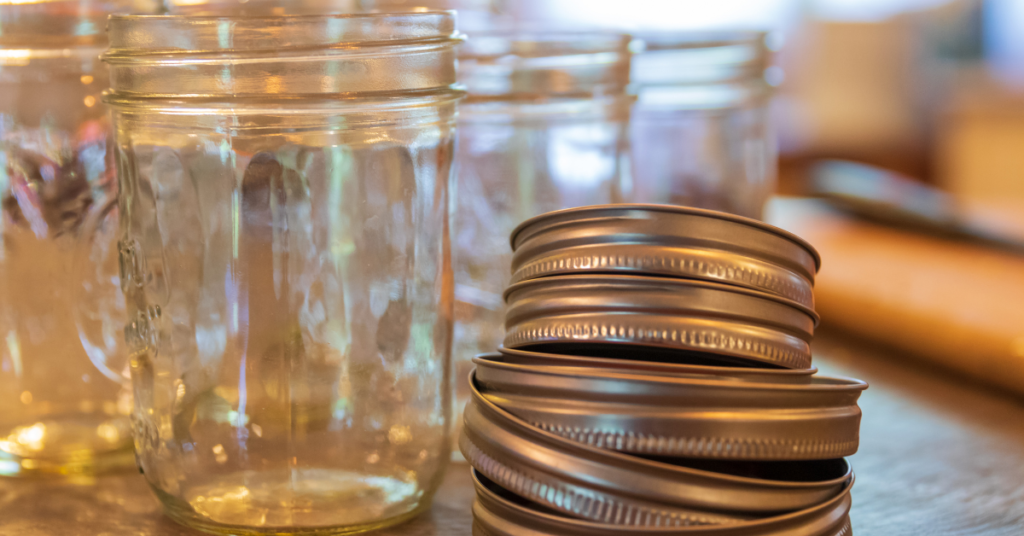
There are two ways to can your food:
Water Bath Canning for Vegetables
Water bath canning is a popular method for preserving high-acid foods. However, vegetables are low-acid foods and require additional measures to prevent the risk of botulism. Therefore, it is necessary to use pressure canning for most vegetables to ensure safety.
However, some vegetables with a high acid content, such as tomatoes, pickles, and other high-acid fruits, can be safely water bath canned. These types of canned goods can be stored for up to 12 to 18 months, provided they are stored in a cool, dark place.
Keep in mind that while these canned items may be safe to eat beyond the recommended storage durations, the quality may deteriorate over time. Moreover, it is crucial to inspect the jars for any signs of spoilage, such as bulging lids or foul odors, before consumption.[1]
Pressure Canning for Meat, Fish, Soup, and Stew
Pressure canning is essential for the preservation of low-acid foods, such as meat, fish, soups, and stews. This method uses high temperature and pressure to destroy harmful bacteria and spores, providing a long shelf life for these products.
When properly sealed and processed, the shelf life of meat, fish, soup, and stew can reach up to 2 to 5 years, depending on the specific food item. The storage duration varies due to factors such as ingredients, processing methods, and storage conditions.[2]
Maximizing Shelf Life of Canned Foods
To maximize the shelf life of canned foods, here are some practical tips and best practices to follow:
- Choose fresh and high-quality ingredients: Canned foods are only as good as the ingredients used. Select fresh produce and protein sources and process them promptly after harvesting or purchasing.
- Follow-tested recipes: Use only trustworthy and up-to-date canning recipes from authoritative sources that have been tested for safety and quality.
- Practice proper canning techniques: Adhere to the recommended processing times and pressures specific to your food item and canning method. Always use suitable canning jars, lids, and bands to ensure a proper seal.
- Monitor storage conditions: Store canned goods in a cool, dark place to maintain quality and safety. Keep track of inventory and consume older jars before newer ones to avoid wasting food.
Health Risks, Quality Deterioration, and Signs of Spoilage
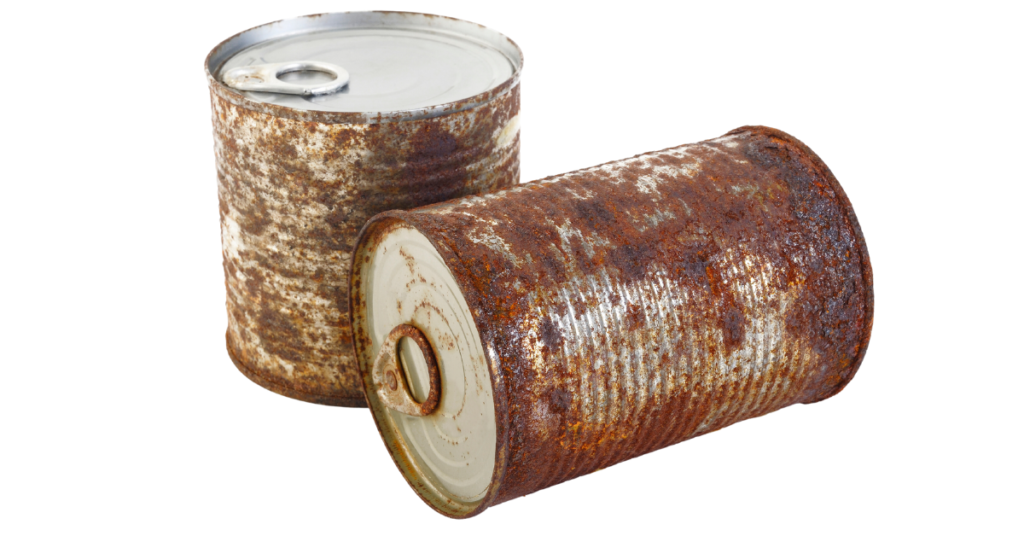
While home canning is generally safe, there are potential health risks associated with improper techniques. Botulism is a severe form of food poisoning caused by the toxin produced by the bacteria Clostridium botulinum.
This bacterium can grow in improperly canned low-acid foods in the absence of oxygen. That is why it is essential to follow proper canning methods and guidelines.
Quality deterioration is another consideration. Over time, the flavor, texture, and nutritional value of canned foods may decline. The longer foods are stored, the more likely they will lose their quality attributes. Therefore, it is recommended to consume canned goods within the recommended storage durations for the best taste and nutritional value.
To detect spoilage, examine the jars before consumption. Signs of spoilage include bulging lids, leaking liquid, mold growth, or an off smell. If any of these signs are present, do not consume the product, as it may indicate bacterial growth or spoilage.
Food Grade Buckets with Oxygen Absorbers
Food-grade buckets are a convenient option for long-term food storage, especially for bulk items like grains, pasta, and legumes. When paired with oxygen absorbers, food grade buckets create an oxygen-free environment, extending the shelf life of food.
This method is cost-effective, durable, and often stackable, optimizing limited storage space.
However, these buckets are less suitable for regular access to stored food, as opening the sealed container exposes all contents to air and can lead to spoilage.
Glass Jars with a Fitted Lid and Rubber Protective Band
Glass jars are ideal for storing grains, nuts, seeds, and other dry goods. The glass provides an airtight seal to keep the food items safe from contamination and is easy to transport. Glass jars come in various sizes and designs, making them a great way to organize your pantry.
They have a fitted lid and rubber protective band that offer a reliable alternative to Mason jars. These jars provide an airtight seal, preventing oxygen and moisture from reaching stored food.
Glass preserves food quality and does not interact chemically with the contents. However, glass jars can be fragile and cumbersome, requiring careful transportation and handling.
Vacuum Sealer Bags
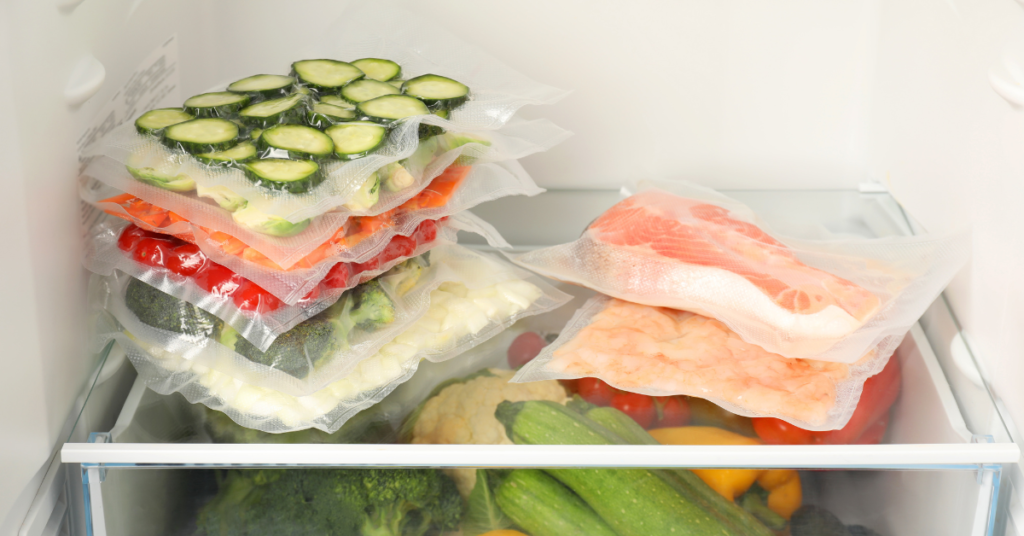
Vacuum sealing is a great way to store food items for long periods. Vacuum-sealing machines remove all the air from bags and provide an airtight seal. It helps keep food items fresh for a long time and is ideal for storing meats, fish, and other perishables.
Vacuum sealer bags are highly efficient in removing air from packaging, drastically reducing the chances of food spoilage. By eliminating oxygen, the growth of aerobic bacteria is inhibited.
We use vacuum sealer bags that allow compact storage and are widely available. Nevertheless, investing in a vacuum sealer machine can be costly, and the bags themselves have a high single-use plastic footprint.
Plastic Containers
Plastic containers are ideal for storing food items such as fruits, vegetables, and other perishables. Plastic containers come in various sizes and designs, making them great for organizing your pantry. They provide an airtight seal to keep food items fresh and easily transported.
Benefits of Long-Term Food Storage Methods
- Prolonged Shelf Life: Each method mentioned above contributes to extending the shelf life of food, ensuring availability during prolonged emergencies.
- Preserving Nutritional Value: Properly stored food retains its nutritional value, essential for maintaining health and well-being in times of crisis.
- Cost-Effectiveness: Long-term food storage methods can help save money by purchasing in bulk or preserving homegrown produce.
- Redundancy: Utilizing varied storage methods prevents total loss in case of failures or damage to specific storage systems.
Container Shelf Life
Proper food storage is crucial to maintain the nutritional value, quality, and safety of various food items.
The shelf life of food can significantly differ depending on the storage container used.
Grains
Grains, such as rice, wheat, oats, and corn, have extended shelf lives if stored properly.
Here are the maximum storage durations for grains:
| Container | Shelf Life |
|---|---|
| Mylar Bags | Up to 25 years |
| Plastic Containers | Up to 5 years |
| Glass jars/Mason jars | Up to 2 years |
| Vacuum Sealer Bags | Up to 2 years |
| Plastic Food-Grade Buckets | Up to 5 years |
Tips for proper storage
- Label the container with the food item, purchase date, and storage duration.
- Store in a cool, dry place away from direct sunlight and moisture.
- Opt for airtight containers to prevent insect infestation and moisture absorption.
Dried Fruits
Dried fruits, including raisins, apricots, dates, and cranberries, have a limited shelf life due to their moisture content. Here are the maximum storage durations for dried fruits:
| Container | Shelf Life |
|---|---|
| Mylar Bags | Up to 2 years |
| Plastic Containers | Up to 1 year |
| Glass jars/Mason jars | Up to 1 year |
| Vacuum Sealer Bags | Up to 1 year |
| Plastic Food-Grade Buckets | Up to 2 years |
Tips for proper storage
- Label the container with the fruit type, purchase date, and storage duration.
- Keep in a cool, dark place to preserve color, texture, and flavor.
- Check for any signs of spoilage, such as mold or off odors, before consumption.
Canned Goods
Canned goods, such as vegetables, fruits, beans, and soups, can have a long shelf life if stored correctly.
Here are the maximum storage durations for canned goods:
| Container | Shelf Life |
|---|---|
| Mylar Bags | Not suitable for canned goods storage |
| Plastic Containers | Up to 2 years |
| Glass jars/Mason jars | Up to 2 years |
| Vacuum Sealer Bags | Not suitable for canned goods storage |
| Plastic Food-Grade Buckets | Up to 2 years |
Tips for proper storage
- Check for any dents, bulges, or leaks before storing.
- Label the container with the contents, purchase date, and storage duration.
- Store in a cool, dry place, away from extreme temperatures and direct sunlight.
Perishables (Meats and Dairy Products)
Perishable food items, such as meats, poultry, fish, and dairy products, have shorter shelf lives and require careful storage.
Here are the maximum storage durations for perishable items:
| Container | Shelf Life |
|---|---|
| Mylar Bags | Not suitable for perishable items storage |
| Plastic Containers | Meats: 2-4 days; Dairy products: Refer to the expiration date on the packaging |
| Glass jars/Mason jars | Not suitable for perishable items storage |
| Vacuum Sealer Bags | Meats: 2-3 years (freezer), 7-14 days (fridge) Dairy products: Not suitable |
| Plastic Food-Grade Buckets | Not suitable for perishable items storage |
Tips for proper storage
- Refrigerate or freeze perishable items promptly after purchase.
- Follow the manufacturer’s storage recommendations for dairy products.
- Label the container with the item, purchase date, and appropriate storage conditions.
- Never consume spoiled or expired perishable items.
Potential Risks Associated with Storage Methods
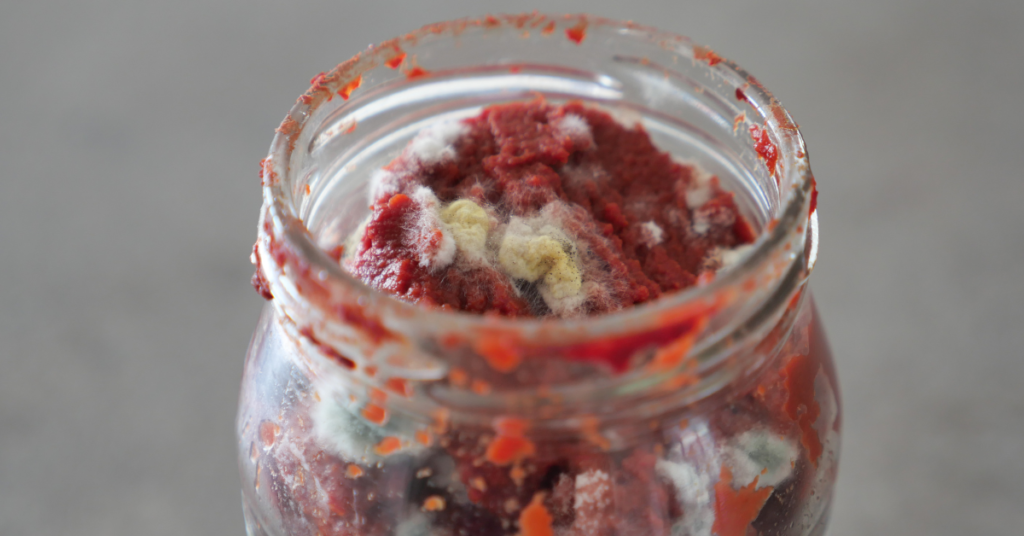
- Mylar bags: Puncturing or improper sealing can lead to air and moisture exposure.
- Plastic containers: Susceptible to cracking, discoloration, and odor absorption.
- Glass jars/Mason jars: Risk of breakage and potential contamination if not sealed properly.
- Vacuum sealer bags: Vulnerable to punctures and loss of vacuum seal integrity.
- Plastic food-grade buckets: Can absorb odors and may degrade over time.
Proper food storage is essential for maintaining food quality, safety, and extending shelf life.
Understanding various food items’ maximum storage durations and the efficacy of different storage containers gives you the ability to make informed decisions.
By following the provided tips on proper labeling, storing conditions, and potential risks associated with each storage method, you can safeguard your stored food items and reduce waste.
Remember, regular inspection and adherence to the expiration dates are crucial to ensure the safety of consumed food.
Food Security Importance
- Reducing Dependency: Long-term food storage builds self-sufficiency, reducing reliance on external sources during emergencies.
- Mitigating Shortages: Natural disasters, political instability, and global crises can lead to unpredictable food shortages. Proper storage methods reduce vulnerability in times of scarcity.
- Peace of Mind: Having a reliable food security plan instills confidence and peace of mind, enabling individuals to focus efforts on other essential aspects of survival.
Whether you are storing food items in Mylar bags, glass jars, plastic containers, or vacuum-sealing them, there are several things to consider before purchasing.
For instance, you should consider size, shape, material, and airtight seal factors to get the most out of your food storage solutions.
Here is a comprehensive analysis of what to consider when choosing food storage solutions.
Size and Shape
Choose a size and shape suitable for the food item you are storing. For example, if you store grains and nuts, a glass jar with a wide mouth will be more suitable than a plastic container.
You can also consider the amount of food you are storing and choose a container or bag that is big enough for it.
Material
The material used for food storage solutions affects the durability and airtight seal. If using Mylar bags, we recommend multi-layered to provide better protection.
For glass jars and plastic containers, ensure it is BPA-free so it does not leach toxins into your food supply.
Airtight Seal
Airtight seals are essential for food storage because they help keep food items fresh and safe from contamination.
Mylar bags, glass jars, and plastic containers provide an airtight seal to keep food items safe. Vacuum-sealing machines can also be used for a higher level of protection.
FAQ
What is the best option for long-term food storage?
The best option varies based on the food type. Mylar Bags, Mason Jars, and Food-Grade Buckets with Oxygen Absorbers are among the top choices for various foods.
How long does long-term food storage last?
It varies. For instance, grains in Mylar Bags can last up to 25 years, while some canned goods can last 2-5 years, depending on storage conditions.
What are the benefits of long-term food storage methods?
Long-term food storage methods offer several benefits, including prolonged shelf life, preserving nutritional value, cost-effectiveness, and redundancy. They also reduce dependency on external sources during emergencies, mitigate potential food shortages, and provide peace of mind.
What foods should I stockpile now?
Grains, dried fruits, and certain canned goods are top choices. Mylar-bagged grains, in particular, have an extended shelf life.
How do I build my 6-month food supply?
Calculate monthly food consumption, multiply by six, prioritize non-perishable items, and invest in proper storage solutions. Regularly check and rotate stock.
How do I ensure the safety and quality of canned foods?
Always use trustworthy and up-to-date canning recipes from authoritative sources. Adhere to the recommended processing times and pressures specific to your food item and canning method. Store canned goods in a cool, dark place and inspect jars for signs of spoilage before consumption.
What are the potential risks associated with different storage methods?
Each storage method has its potential risks. For example, Mylar bags can be punctured if not handled with care. Plastic containers might crack or absorb odors. Glass jars can break, and vacuum sealer bags can lose their seal integrity. It’s essential to be aware of these risks and handle storage containers appropriately.
Conclusion
Long-term food storage is a crucial aspect of preparedness, benefiting preppers, survivalists, and homesteaders alike.
By employing appropriate storage methods such as mylar bags, Mason jars, food grade buckets with oxygen absorbers, glass jars with a fitted lid and rubber protective band, and vacuum sealer bags, individuals can safeguard their food against the adverse effects of oxygen, moisture, pests, and light.
While each method has its unique attributes, prudent selection and a combination of methods further enhance food security.
By adopting long-term food storage techniques, you can ensure a reliable supply of quality food during times of crisis, enhancing your overall resilience and ability to thrive in a post-disaster scenario.
